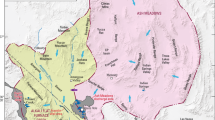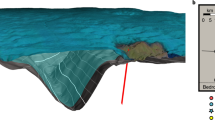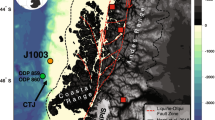Abstract
Sea-level fluctuations, particularly those associated with glacial–interglacial cycles, can have profound impacts on the flow and circulation of coastal groundwater: the water found at present in many coastal aquifers may have been recharged during the last glacial period, when sea level was over 100 m lower than present1,2, and thus is not in equilibrium with present recharge conditions3,4,5,6,7,8,9. Here we show that the geochemistry of the groundwater found in the Floridan Aquifer System in south Florida is best explained by a reorganization of groundwater flow following the sea-level rise at the end of the Last Glacial Maximum approximately 18,000 years ago. We find that the geochemistry of the fresh water found in the upper aquifers at present is consistent with recharge from meteoric water during the last glacial period. The lower aquifer, however, consists of post-sea-level-rise salt water that is most similar to that of the Straits of Florida, though with some dilution from the residual fresh water from the last glacial period circulation. We therefore suggest that during the last glacial period, the entire Floridan Aquifer System was recharged with meteoric waters. After sea level rose, the increased hydraulic head reduced the velocity of the groundwater flow. This velocity reduction trapped the fresh water in the upper aquifers and initiated saltwater circulation in the lower aquifer.
This is a preview of subscription content, access via your institution
Access options
Subscribe to this journal
Receive 12 print issues and online access
$259.00 per year
only $21.58 per issue
Buy this article
- Purchase on Springer Link
- Instant access to full article PDF
Prices may be subject to local taxes which are calculated during checkout



Similar content being viewed by others
References
Fairbanks, R. G. A 17,000-year glacio-eustatic sea level record: Influence of glacial melting rates on Younger Dryas event and deep-ocean circulation. Nature 342, 637–642 (1989).
Lambeck, K. & Chappell, J. Sea level change through the last glacial cycle. Science 27, 679–686 (2001).
Edmunds, W. M. & Milne, C. J. (eds) Paleowaters in Coastal Europe: Evolution of Groundwater Since the Late Pleistocene (Special Publication No. 189, Geological Society, 2001).
Cohen, D. et al. Origin and extent of fresh paleowaters on the Atlantic continental shelf, USA. Ground Wat. 48, 143–158 (2010).
Person, M., McIntosh, J., Bense, V. & Remenda, V. H. Pleistocene hydrology of North America: The role of ice sheets in reorganizing groundwater flow systems. Rev. Geophys. 45, RG3007 (2007).
Love, A. J. et al. Groundwater residence time and palaeohydrology in the Otway Basin, South Australia: 2H, 18O and 14C data. J. Hydrol. 153, 157–187 (1994).
Plummer, L. N. & Sprinkle, C. L. Radiocarbon dating of dissolved inorganic carbon in groundwater from confined parts of the Upper Floridan aquifer, Florida, USA. Hydrogeol. J. 9, 127–150 (2001).
Meyer, W. F. Hydrogeology, Ground-Water Movement, and Subsurface Storage in the Floridan Aquifer System in Southern Florida (US Geological Survey Professional Paper 1403-G, US Geological Survey, 1989).
Hughes, J. D., Vacher, H. L. & Sanford, W. E. Temporal response of hydraulic head, temperature, and chloride concentrations to sea-level changes, Floridan aquifer system, USA. Hydrogeol. J. 17, 793–815 (2009).
Reese, R. S. & Richardson, E. Synthesis of the Hydrogeologic Framework of the Floridan Aquifer System and Delineation of a Major Avon Park Permeable Zone in Central and South Florida (US Geological Survey Scientific Investigation Report 2007–5207, US Geological Survey, 2008).
Aeschbach-Hertig, W., Peeters, F., Beyerle, U. & Kipfer, R. Interpretation of dissolved atmospheric noble gases in natural waters. Wat. Resour. Res. 35, 2779–2792 (1999).
Aeschbach-Hertig, W., Peeters, F., Beyerle, U. & Kipfer, R. Paleotemperature reconstruction from noble gases in ground water taking into account equilibration with entrapped air. Nature 405, 1040–1044 (2000).
Stute, M., Schlosser, P., Clark, J. F. & Broecker, W. S. Paleotemperatures in the Southwestern United States derived from noble gases in ground water. Science 256, 1000–1003 (1992).
Stute, M., Clark, J. F., Schlosser, P. & Broecker, W. S. A 30,000 yr continental paleotemperature record derived from noble gases dissolved in groundwater from the San Juan Basin, New Mexico. Quat. Res. 43, 209–220 (1995).
Clark, J. F. et al. A tracer study of the Floridan aquifer in southeastern Georgia: Implications for groundwater flow and paleoclimate. Wat. Resour. Res. 33, 281–289 (1997).
Clark, J. F., Davisson, M. L., Hudson, G. B. & Macfarlane, P. A. Noble gases, stable isotopes, and radiocarbon as tracers of flow in the Dakota aquifer, Colorado and Kansas. J. Hydrol. 211, 151–167 (1998).
Bottomley, D. E., Ross, J. D. & Clarke, W. B. Helium and neon isotopes geochemistry of some groundwaters from the Canadian Precambrian Shield. Geochim. Cosmochim. Acta 48, 1973–1985 (1984).
Torgersen, T. & Ivey, G. N. Helium accumulation in groundwater: II. A model for the accumulation of the crustal 4He degassing flux. Geochim. Cosmochim. Acta 49, 2445–2452 (1985).
Kipfer, R., Aeschbach-Hertig, W., Peeters, F. & Stute, M. in Noble Gases in Geochemistry and Cosmochemistry (eds Porcelli, D., Ballentine, C. J. & Wieler, R.) 615–700 (Reviews in Mineralogy and Geochemistry, Vol. 47, Geochemical Society, The Mineralogical Society of America, 2002).
Condesso de Melo, M. T., Carreira Paquette, P. M. M. & Marques da Silva, M. A. in Paleowaters in Coastal Europe: Evolution of Groundwater Since the Late Pleistocene (eds Edmunds, W. M. & Milne, C. J.) 139–154 (Special Publication No. 189, Geological Society, 2001).
Hamme, R. C. & Severinghaus, J. P. Trace gas disequilibria during deep-water formation. Deep-Sea Res. 54, 939–950 (2007).
Schrag, D. P., Hampt, G. & Murray, D. W. Pore fluid constraints on the temperature and oxygen isotopic composition of the glacial ocean. Science 272, 1930–1932 (1996).
Schrag, D. P. et al. The oxygen isotopic composition of seawater during the Last Glacial Maximum. Quat. Sci. Rev. 21, 331–342 (2002).
Lynch-Stieglitz, J., Curry, W. B. & Slowey, N. Weaker gulf stream in the Florida Straits during the Last Glacial Maximum. Nature 402, 644–647 (1999).
Kohout, F. A. A hypothesis concerning cyclic flow of salt water related to geothermal heating in the Floridan aquifer. New York Acad. Sci. Trans. 28, 249–271 (1965).
Sanford, W. E., Whitaker, F. F., Smart, P. L. & Jones, G. D. Numerical analysis of seawater circulation in carbonate platforms: I. Geothermal convection. Am. J. Sci. 298, 801–828 (1998).
Cooper, H. H. Jr. A hypothesis concerning the dynamic balance of fresh water and salt water in a coastal aquifer. J. Geophys. Res. 64, 461–467 (1959).
Hughes, J. D., Vacher, H. L. & Sanford, W. E. Three-dimensional flow in the Florida platform: Theoretical analysis of Kohout convection at its type locality. Geology 35, 663–666 (2007).
Acknowledgements
This project was supported by the South Florida Water Management District and the Collaborative UC/Los Alamos Research programme. We thank SFWMD field personnel for their assistance collecting well samples and L. Barker and J. Lippmann for analysing the noble-gas samples. R. Wanninkhof and M. Baringer assisted with the collection of the ocean water from the Straits of Florida. The manuscript was improved as a result of insightful comments made by N. L. Plummer (USGS).
Author information
Authors and Affiliations
Contributions
J.F.C. and M.B. conceived the study. M.B. and E.R. organized the field collection events. M.S. conducted the noble-gas analyses. J.F.C., S.K.M., M.B. and E.R. implemented the other geochemical analyses. All authors participated in data discussion and interpretation. S.K.M. and J.F.C. wrote the initial manuscript, and all authors provided substantial comments and editorial revisions to the manuscript.
Corresponding author
Ethics declarations
Competing interests
The authors declare no competing financial interests.
Supplementary information
Supplementary Information
Supplementary Information (PDF 353 kb)
Rights and permissions
About this article
Cite this article
Morrissey, S., Clark, J., Bennett, M. et al. Groundwater reorganization in the Floridan aquifer following Holocene sea-level rise. Nature Geosci 3, 683–687 (2010). https://doi.org/10.1038/ngeo956
Received:
Accepted:
Published:
Issue Date:
DOI: https://doi.org/10.1038/ngeo956
This article is cited by
-
3D characterisation and quantification of an offshore freshened groundwater system in the Canterbury Bight
Nature Communications (2020)
-
Global aquifers dominated by fossil groundwaters but wells vulnerable to modern contamination
Nature Geoscience (2017)
-
Offshore fresh groundwater reserves as a global phenomenon
Nature (2013)
-
Use of a vertical δ18O profile to constrain hydraulic properties and recharge rates across a glacio-lacustrine unit, Nantucket Island, Massachusetts, USA
Hydrogeology Journal (2012)
-
Coastal flow
Nature Geoscience (2010)



